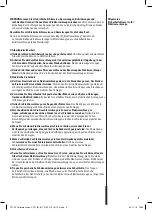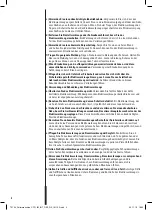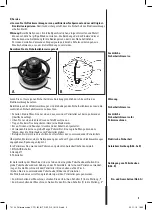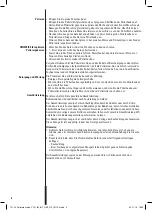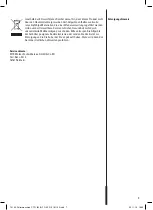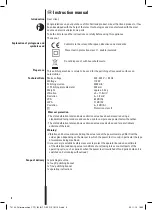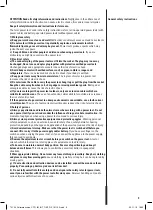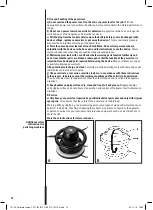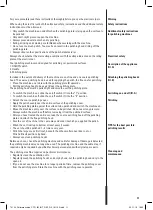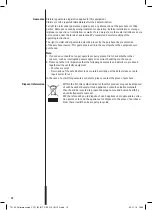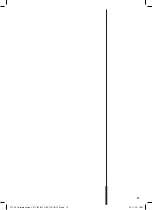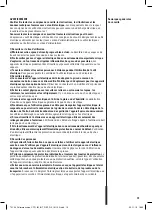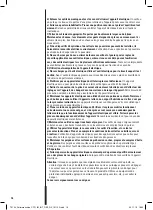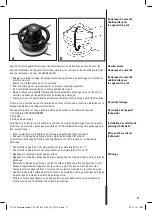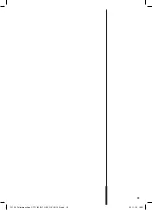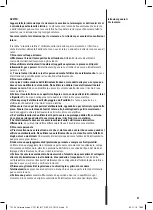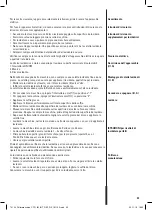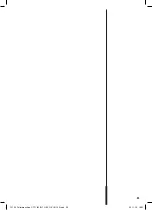
10
4) Use and handling of the power tool
a)Do not overload the power tool. Use the correct power tool for the job.
With the
appropriate power tool you will work better and more safely within the stated performance
range.
b) Do not use a power tool whose switch is defective.
A power tool which can no longer be
switched on or off is dangerous and must be repaired.
c) Pull the plug from the socket and/or remove the battery before you make changes to the
device settings, replace accessories or put away the device.
This precautionary measure
prevents the unintentional start-up of the power tool.
d) Store the unused power tool out of reach of children. Do not allow persons who are
unfamiliar with the device or who have not read the instructions to use the device.
Power
tools are dangerous when they are used by inexperienced persons
.
e) Maintain power tools with care. Check whether moving parts function faultlessly and
do not jam, whether parts are broken or damaged so that the function of the power tool is
impaired. Have damaged parts repaired before using the device.
Many accidents occur due
to poorly maintained power tools.
f) Keep cutting tools sharp and clean.
Carefully maintained cutting tools with sharp edges get
jammed less and are easier to guide.
g) Use power tools, accessories, insertion tools etc. in accordance with these instructions.
In the process, take into account the working conditions and the activity to be performed.
The use of power tools for applications other than the intended ones can lead to dangerous
situations.
h) Keep handles and grip surfaces dry, clean and free of oil and grease.
Slippery handles
and gripping surfaces do not allow safe operation and control of the power tool in unforeseen
situations.
5) Service
a) Only have your power tool repaired by qualified technical personnel and only with original
spare parts.
This ensures that the safety of the power tool is maintained.
Warning: When grinding e.g. lead-containing paint, some types of wood and metal may cause
harmful / toxic dusts. Touching or inhaling these dusts may present a hazard to the operator
or persons nearby. Use your own personal protective equipment, such as a dust mask etc. to
avoid the risk.
Store these instructions for future reference.
Additional safety
instructions for
polishing machines
For your own safety read these instructions thoroughly before you use the electronic tools.
When using the electric tool both the attacked safety instructions and the additional safety
instructions must be observed.
• Only switch the machine on and off when the polishing plate is lying upon the surface to
be polished.
• Only exert slight pressure upon the machine.
• Always wear a dust mask when dry polishing.
• Eating, drinking and smoking are forbidden when working with the machine.
• Do not use too much polish. Too much can result in the polishing hood sliding off the
polishing plate.
• Always observe the specifications of the polish manufacturer.
Always check whether the main voltage complies with the voltage indicated on the rating
plate of the electric tool.
Your polishing machine was designed for polishing car paintwork surfaces.
1. ON/OFF switch
2. Handle
3. Polishing plate
Included in the extent of delivery of the machine are one fine and one coarse polishing
hood. The coarse polishing hood is used for applying the polish, the fine one for polishing.
• Place the machine on a table with the polishing plate (3) upwards.
• Pull the polishing hood to be used (4) over the polishing plate.
The polishing hood must be pulled tight and smooth over the polishing plate.
• To switch the machine on slide the on/off switch (1) into the “1” position.
• To switch the machine off slide the on/off switch (1) into the “0” position.
• Attach the coarse polishing cover.
• Apply the polish evenly over the entire surface of the polishing cover.
• Hold the polishing plate against the surface to be polished and switch the machine on.
• Move the machine evenly over the surface to be polished. Do not exert any pressure.
Always switch the machine off before removing it from the polished surface.
• After you have treated the entire car, take the coarse polishing hood off the polishing
plate and attach the fine polishing hood.
• Give the car a fine shine in the same way and order in which you applied the polish.
• Wash the car from top to bottom at least every 2 weeks.
• The car should be polished 1 – 2 times every year.
• Polish the large areas first (roof, bonnet), then the smaller ones (doors, etc.).
Polish difficult positions by hand.
• Always use clean polishing hoods.
Before each use, check the polishing machine and cable for damage. If damage is detected,
the polishing machine may no longer be used. The polishing machine and the cable may, if
required, only be repaired by qualified technical personnel and with original spare parts.
The polishing machine requires no particular maintenance.
• Regularly clean the ventilation slits.
• Regularly wash the polishing hoods and only by hand. Let the polishing hoods dry in the
open air.
• IIf you do not use the machine for a longer period of time, remove the polishing cover
from the polishing plate. Store the machine with the polishing cover upwards.
A
B
3
1
2
72134_Poliermaschine_CTR_IM_INT_OEF_RZ_191125.indd 10
72134_Poliermaschine_CTR_IM_INT_OEF_RZ_191125.indd 10
25.11.19 18:02
25.11.19 18:02



